Makers vs Managers: The Battle Over Remote Work
By Twist Team

Makers and managers are locked in a productivity power struggle where the battleground is the calendar and diminished focus and lost hours are what’s at stake. Paul Graham’s 2009 essay, “Maker’s Schedule, Manager’s Schedule”, describes the differences that lead these these two factions to clash:
“The manager's schedule is for bosses. It's embodied in the traditional appointment book, with each day cut into one hour intervals. You can block off several hours for a single task if you need to, but by default you change what you're doing every hour.”
On the other hand, makers operate effectively on a different schedule entirely — one that prioritizes focus:
“...there's another way of using time that's common among people who make things, like programmers and writers. They generally prefer to use time in units of half a day at least. You can't write or program well in units of an hour. That's barely enough time to get started. When you're operating on the maker's schedule, meetings are a disaster. A single meeting can blow a whole afternoon, by breaking it into two pieces each too small to do anything hard in.”
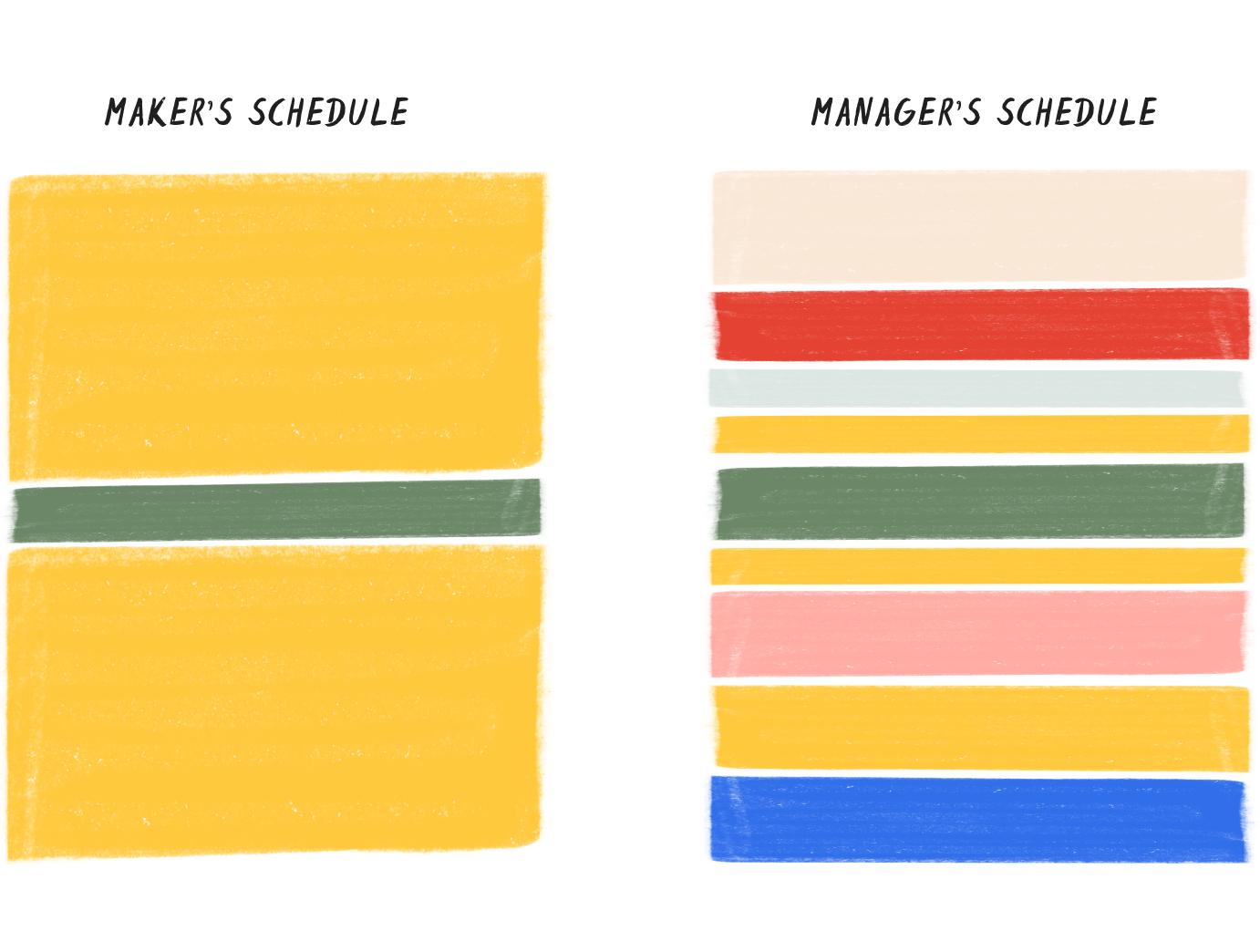
Both makers and managers, or roughly equivalent to employees and executives, have important roles in the workplace and both schedules serve a different purpose. But as Graham observes, when they collide, managers generally win at the cost of makers’ ability to get things done:
“Each type of schedule works fine by itself. Problems arise when they meet. Since most powerful people operate on the manager's schedule, they're in a position to make everyone resonate at their frequency if they want to.”
Over a decade has passed since Graham published his essay and his observations resonate even more in today’s workplace. The rise of the open floor plan offices opens makers up to even more distractions and interruptions throughout the workday. The ubiquity of team chat apps like Slack have only exacerbated the problem, trading meetings and email for all-day group chats. While managers and makers across companies often agree there’s a problem, they’ve simply added band aid fixes like “No Meeting Tuesdays” or “Work from Home Wednesdays”.
But there’s another big shift happening in work with the potential to move the maker’s schedule from the back-burner to the default: the rise of remote work. Working remotely is free from many of the trappings of modern workplaces including noisy open offices, constant shoulder taps, and a calendar full of meetings.
Pre-COVID, remote startups and companies alike have pioneered distributed work models that are remote and, to a large extent, async-first, choosing intentional communication over constant connectivity. Post-COVID, there’s an opportunity for companies newly embracing remote work to do the same. Rather than replicating the office with all-day Zoom calls and constant Slack pings, they have a chance to reimagine how work gets done that respects makers’ need for focus. As remote work continues to surge, there’s hope for the restoration of deep work to the workplace.
Makers can thrive in their roles rather than serving as seat warmers in another meeting. Managers can embrace disconnection too; hours once used for jumping from meeting to meeting can be reserved for strategic thinking and planning. In remote-first companies, everyone has the potential to do their best work by embracing a schedule that centers on focus. Offices have been built around the needs of managers at the expense of makers; the move to remote work offers a rare opportunity to shift the balance.
Diverging attitudes about remote work
Early in the pandemic, while many were still finding their work-from-home bearings, employees were cautiously optimistic about remote work. A July 2020 survey conducted by Morning Consult surveying 2,200 adults found that since the pandemic, 73% reported feeling more positive about the prospect of remote work while 40% reported they would ideally work from home every day post-pandemic.
In a 2020 WeWork survey in partnership with Brightspot Strategy garnering over 600 responses, while 90% of people expressed an interest in returning to the office at least one day a week, only 20% of that group wanted to return five days a week.
As the pandemic wears on and the possibility for business-as-usual diminishes, support for remote work among employees has only strengthened. A March 2021 survey by Harvard Business School garnering over 1500 responses from remote workers found 81% of people who have worked from home through the pandemic either don't want to return to the office or prefer a hybrid schedule. Only 18% reported wanting to return to the office full-time.
Similarly, in April 2021 FlexJobs surveyed more than 2100 people working remotely during the pandemic and found that 65% said they want to remain full-time remote workers after the pandemic. Perhaps most surprisingly, 58% of workers said they would search for a new job if they could not continue remote work in their current role.
Yet managers and executives continue to express reservations. According to Fortune, "an Accenture Plc survey of 400 North American financial-service executives found that 80% prefer that workers spend four to five days in the office when the pandemic is over."
In some sectors like tech where competition in hiring is particularly fierce, executives have listened to their workforce’s strong preference for remote options (or crunched the numbers). Twitter, Square, Coinbase, and Shopify are amongst companies who will operate remote-first or phase out offices altogether. Others like Google have adopted a hybrid approach: 60% of employees will work at the office some of the time, 20% will work from new office locations, while 20% will work from home.
But across many other sectors, it appears some higher-ups will win out — Goldman Sachs has asked most of their employees in the United States and Britain to return to the office by late June, putting an end to remote work. Likewise, JPMorganChase will put a compulsory return to office in place for July. In a widely panned op-ed in the Washington Post, one media executive warned employees that remote work could mean job and benefits cuts.
The insistence on bringing workers back to the office, when they’re both happier and more productive at home, ignores the reality of office culture and its adverse effect on how makers work.
How offices make it hard to actually work
The modern office is hardly a place for getting things done. For reasons that range from physical to cultural, offices tend to encourage communication over focused work. From the distractions caused by open floor plans to the emphasis on constant collaboration, it’s challenging to find the time to actually work.
Offices optimize for busyness
Office cultures often reward the most visible, vocal workers, incentivizing people to “be visible and vocal, often”. This tends to drive perverse incentives and leads to a few unproductive behaviours and outcomes you might recognize in your own workplace:
- Employees arrive early and leave late; they’re in the office before their boss and still seated as they leave.
- Being visible at meetings is rewarded and people tend to fill up their calendars in an attempt to appear present and engaged.
- Quick responses in Slack are expected and team members expected — either explicitly or implicitly — to reply to messages as they arrive.
Unfortunately, these habits amount to productivity theatre. In the absence of easy metrics to measure knowledge work, managers reward what's visible. But despite the ubiquity of the 8-hour work day, most office workers are productive for a fraction of that time. A UK survey of 1,989 office workers found that they were productive for around 2 hours and 53 minutes each day, attributing much of this lost time to distractions like social media and social conversations with colleagues.
Distractions aside, some have hypothesized there’s a cognitive limit to focused work like writing, developing, or designing. In Cal Newport’s Deep Work, he suggests that the limit is four hours. Regardless of the reason, many are simply going through motions at work for most of the day in office settings. The importance of putting in “face time” to earn a promotion or responding quickly to messages to simulate workplace engagement creates a prison of presence.

Meetings fill the work day
In “Maker’s Schedule, Manager’s Schedule”, Graham’s describes the loss of focus and productivity that comes with meetings for workers on a maker’s schedule:
“...I find one meeting can sometimes affect a whole day. A meeting commonly blows at least half a day, by breaking up a morning or afternoon. But in addition there's sometimes a cascading effect. If I know the afternoon is going to be broken up, I'm slightly less likely to start something ambitious in the morning.”
In modern workplaces most employees are individual contributors, largely falling under the “maker” category, and feel the negative impact of fractured days and the stop-start of juggling meetings with deep work. While porting over office culture to remote work can cause the same meeting culture to arise while people work from home, impromptu meetings are easier to suggest when you can walk by someone’s desk and scheduling is easier when everyone is working in the same time zone. The ease of scheduling meetings in the office without consideration for their bigger impact is precisely why they’re such a threat to productivity.
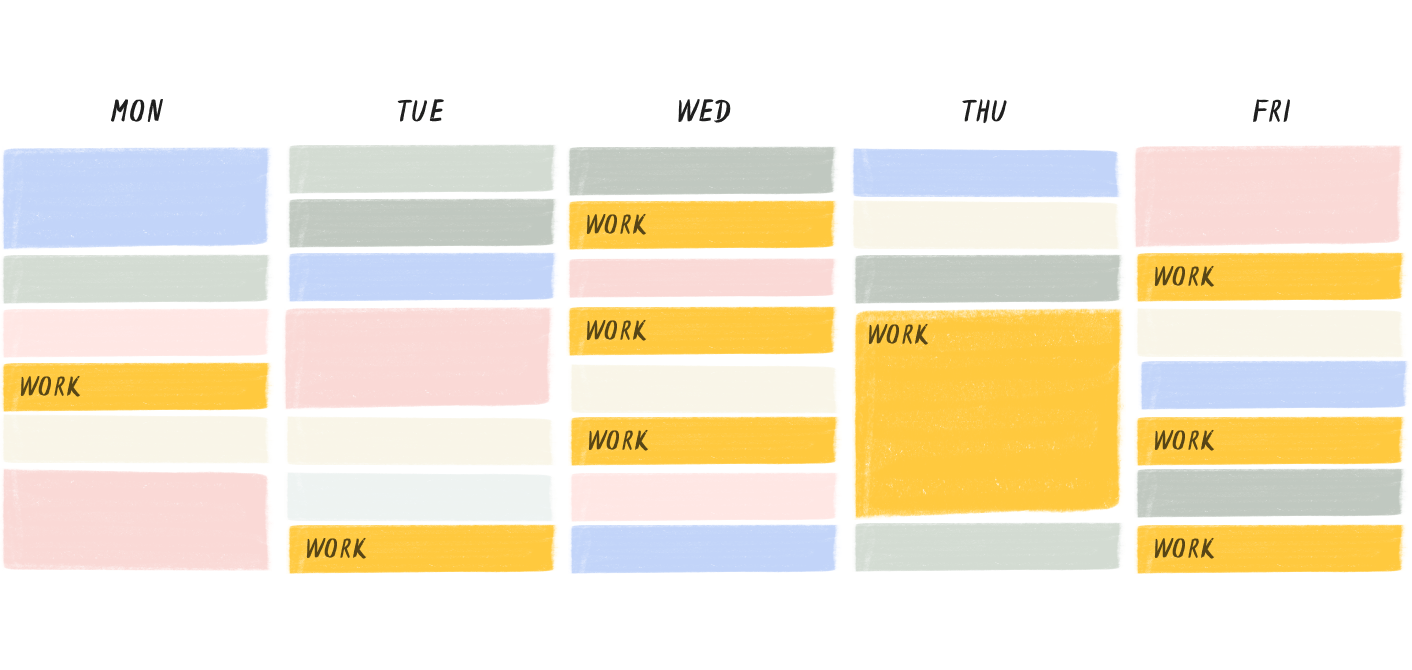
While managers naturally make up a smaller proportion of companies, meeting practices largely tilt towards their preferences:
- Meetings are scheduled for one hour by default
- Meetings that could have been email stretch on for hours
- Meetings are scheduled early in the morning or into the evening
- Meetings are scheduled over existing calendar events of individuals
- Meetings occur throughout the day chipping away at long blocks of focus time
- Meetings invite a host of people to attend rather than key individuals
- Meetings are free-form without clear objectives or a set agenda
- Meetings are unplanned and can pop up at any time
The result is a culture where meetings are prioritized and makers struggle to find enough uninterrupted time to actually do their work.
Open floor plans create distractions
In modern offices, open floor plans are commonplace. Rather than dividers or cubicles separating employees, team members sit shoulder to shoulder working at the same long tables where it’s easy to glance at your deskmate’s screen, listen to their phone conversations at close range, and even hear the music through their noise cancelling headphones. The chatter of salespeople and customer service specialists overrides the quiet concentration of copywriters, designers, and developers.
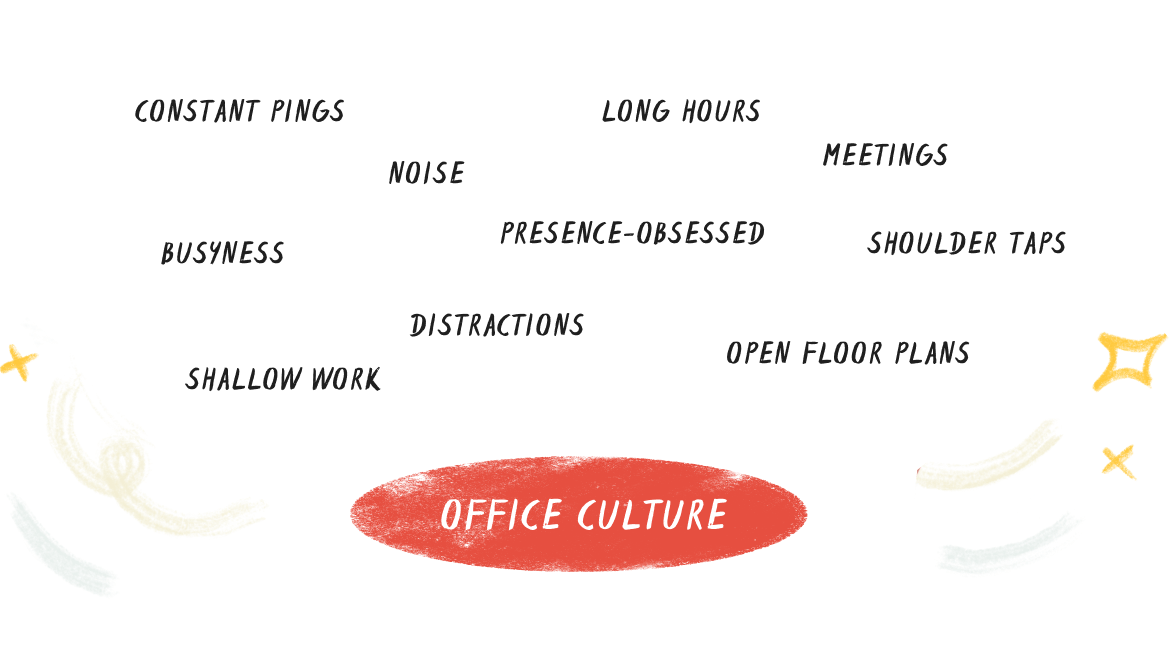
Open floor plans are justified through their ability to generate collaboration across departments and lead to more innovative ideas. But this idea is largely flawed. Newport describes the fallacy of connecting open floor plans to “serendipitous creativity”. Instead, he attributes the innovations and breakthroughs of institutions like Bell Labs to a “hub-and-spoke” arrangement where private offices (spokes) were connected by shared hallways (hubs):
“This combination of soundproofed offices connected to large common areas yields a hub-and-spoke architecture of innovation in which both serendipitous encounter and isolated deep thinking are supported. It’s a setup that straddles a spectrum where on one extreme we find the solo thinker, isolated from inspiration but free from distraction, and on the other extreme, we find the fully collaborative thinker in an open office, flush with inspiration but struggling to support the deep thinking needed to build on it.”
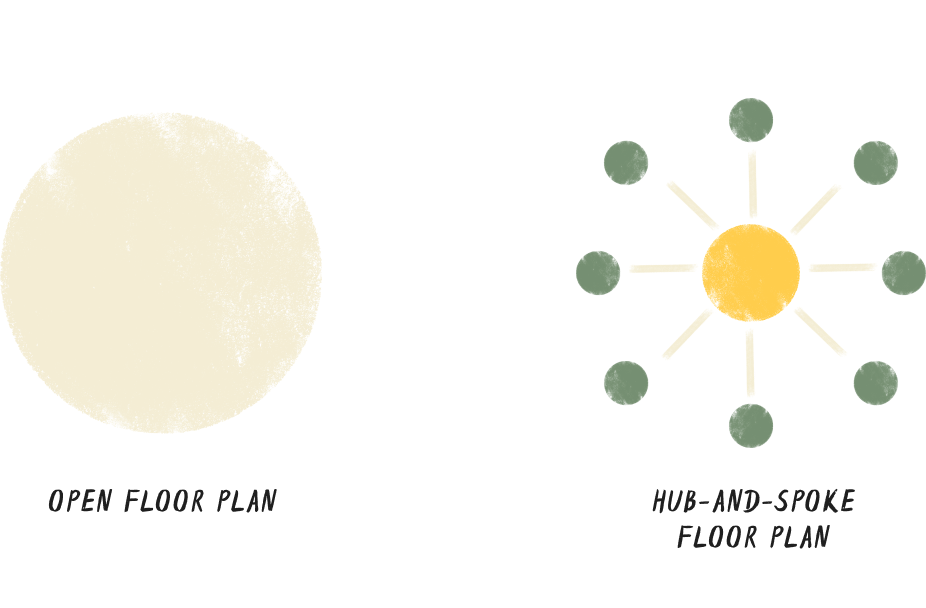
Unfortunately, most workplaces lean into busy open offices where collaboration is overemphasized and individual contribution is sidelined. A survey by RescueTime on interruptions at work found that 64% of respondents said that face-to-face interruptions are the most common (and the most distracting) ones, ahead of email and instant messaging like Slack. Noise levels from coworkers were also cited.
With offices as a low-work zone, employees scramble to finish their work when and where they can actually focus — early mornings, late evenings, and weekends at home. The workday is no longer for work, it's for communicating about work. This disrupts work-life balance and leaves people working around the clock.
These arrangements are a success based on short-term dollars saved and a failure based on productivity lost and well-being sacrificed. A better solution lies in eliminating offices all together.
Why remote work is better for makers
Remote work, whether working from home or intentionally opting for a co-workspace of choice, allows makers to flourish. Far from the expanse of an open office, individuals can dedicate large blocks of their day to focused work in an environment where a makers’ schedule is the default rather than the exception.
Forces a focus on output
At first glance, working remotely seems to reduce managers’ insight into what colleagues are working on and how reports are spending their time. For many leaders, this can be a scary proposition. It’s not uncommon to hear managers ask, “How do I know my team is working?”
The answer doesn’t lie in tracking tools that take random screenshots, measure time online, or any number of invasive practices some companies have turned to. Instead, the solution is much simpler: default to trust. When remote teams start with this foundation, the possibility of a workplace that values productivity over busyness is possible.

Instead of engaging in productivity theatre, makers can truly be assessed for their output, not the number of hours they’re working.
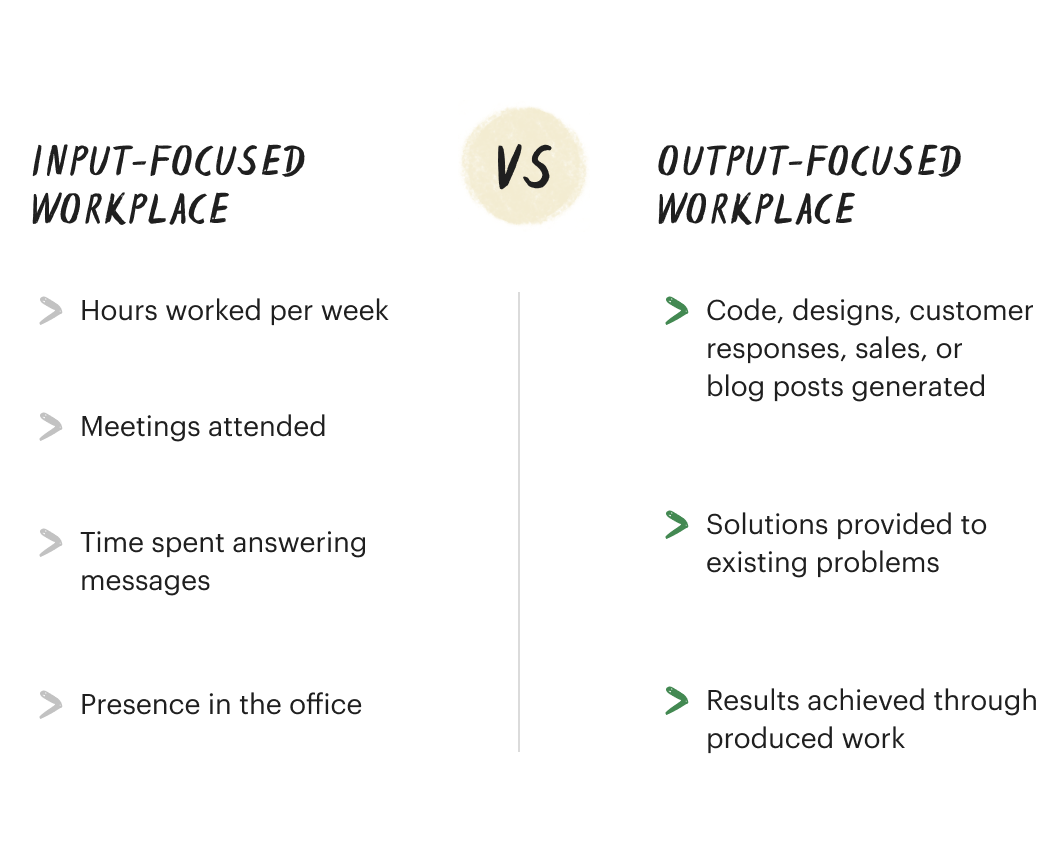
What you produce suddenly becomes much more important than when or where. People begin to fiercely guard their time for working, rather than dedicating it to meetings and team chat that can often be performative. Calendar blocks are protected for chunks of deep work and the maker’s schedule can truly be embraced.
As a result, makers often get more done in less time because it’s focused time. Individuals can stop working around the clock to play catch-up because of time lost in meetings and distractions and more readily embrace balance.
Encourages async communication
In remote teams spread across continents, coordinating synchronous conversations is hard if not impossible. A 10 am meeting in Toronto is a 10 pm meeting in Taipei. Forging ahead with live meetings is a work-life balance disruptor that forces early morning and late evening work on team members. For makers it means having meetings at all hours of the day to touch base with teammates around the world. This leaves little time for deep work.
Some teams quickly recognize this problem but seek a false solution — Slack. With online presence indicators the expectation of immediate responses, and the ephemeral nature of group chat, Slack quickly becomes a synchronous tool. This leaves employees tied to the app around the clock, responding as quickly as they can to the detriment of their real work.
I started off as big a fan of Slack as anyone, but now find it easily 10x more anxiety-inducing and less productive than email. I’m not sure where things went wrong, someone should write a post-mortem.
— Flo Crivello (@Altimor) May 19, 2021
Fortunately, there’s a straightforward solution that remote companies have used for decades to collaborate closely without sacrificing focus: async communication.
By defaulting to async communication, conversations that don’t happen in real-time, teammates can participate in discussions as they’re available. Rather than opting for Zoom calls or Slack messages that require everyone to be online at the same time, remote companies rely predominantly on slow-form writing, whether that’s internal message boards or asynchronous communication tools like Twist. In turn, makers can concentrate on their primary job functions when they’re most productive and make time for async discussions when they’re taking a break from deep work.
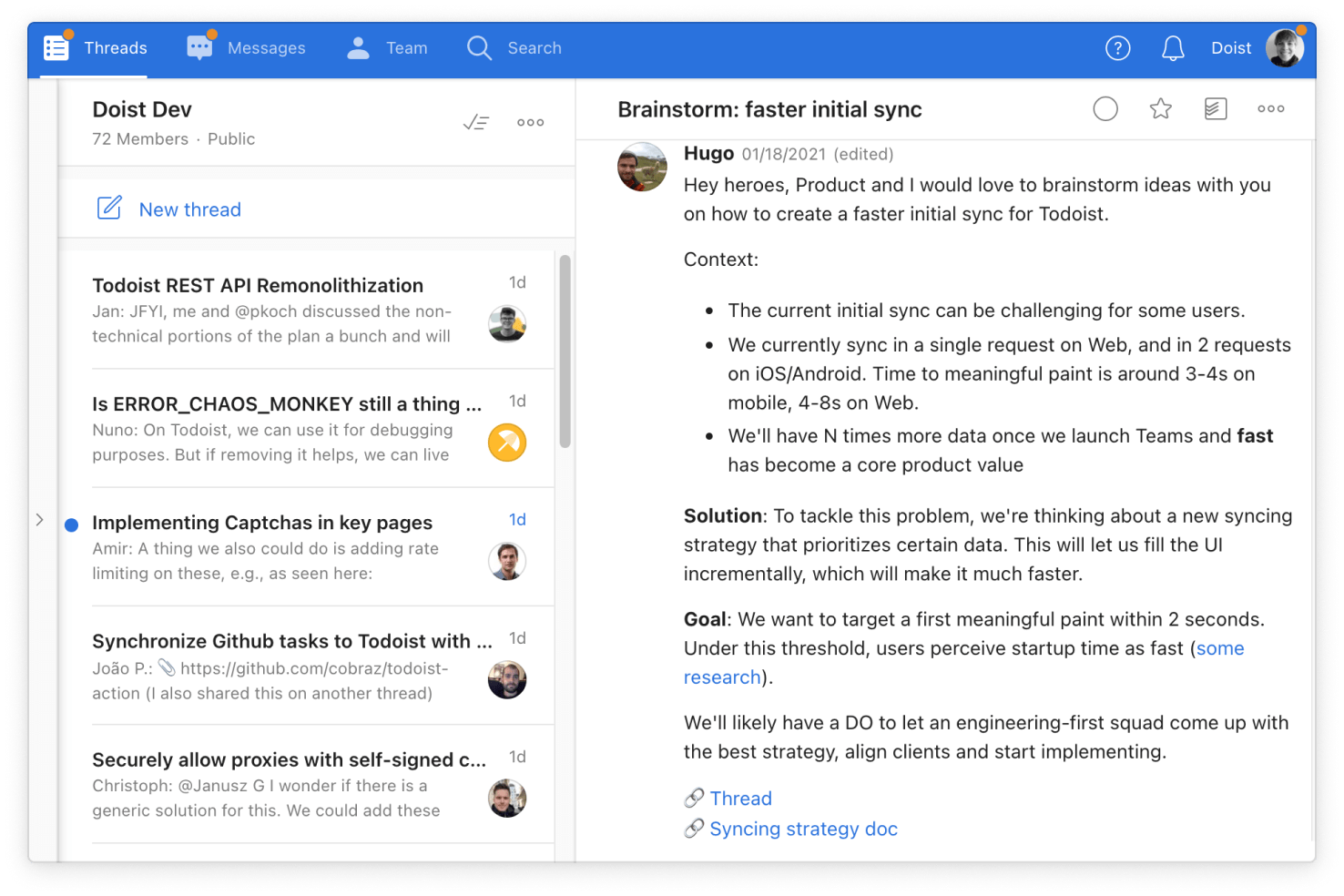
Asynchronous communication is a salve that alleviates the problems of synchronous communication and introduces unexpected benefits:
- Employees don’t have to deal with constant pings and notifications.
- Communication is time zone agnostic and everyone can contribute equally.
- Conversations are more transparent and available for anyone to read.
- Discussions are more thoughtful when people have time to think before they respond.
- Collaboration becomes more planned and intentional.
Async communication helps makers build a schedule that centers around large blocks of deep work rather than fitting in focus in 30-minute slivers between meetings or multi-tasking between team chats.
Allows individuals to optimize their workspaces and workdays
One of the benefits of remote work is the ability to work wherever you want. Remote workers can design their own workplace specifically built around focus. For makers, this is a productivity boon. Rather than sitting in a sea of desks in an open-floor plan office, employees can create a home workspace optimized to do their best work: noise volume, brightness levels, and desired temperature settings are all up to the individual.
This arrangement means makers can truly work during their peak productivity times, not when everyone is cleared out of the office or during evenings and weekends when they can finally hear themselves think.
Additionally, working from home allows everyone to craft the perfect schedule that fits their life or is based on their biorhythms. You can arrange your working hours around your child’s school drop-off and pick-up times, take a walk during your afternoon slump instead of staring blankly at your computer screen, or work late into the evening as a natural night owl.
Instead of imposing the same office environment and work schedule on everyone regardless of their preferences, remote work allows each individual to optimize the way they work best.
How managers can support makers
As Graham discusses in his essay, much of the power in the workplace lies with managers. It’s up to them to recognize how their teams do their best work and set the tone for the workplace accordingly:
“Those of us on the maker's schedule are willing to compromise. We know we have to have some number of meetings. All we ask from those on the manager's schedule is that they understand the cost.”
Here’s what managers and leaders alike can do to balance their need for communication with their employees need for focus:
Embrace remote work (in some form)
As companies shut down their offices and go all-in on remote work, catalyzed by the 2020 global pandemic, it’s worth considering whether this is a viable option at your own company in the long-run. Remote work can create an environment where makers thrive with a newfound ability to focus, an emphasis on async communication, and the ability to optimize their workdays.
Not every company can transition out of the office permanently, in the short-term or the long-term. In these cases, it’s worth considering a remote-ish option where some employees work in the office while others work remotely. The team at Figma, once entirely office-based, have moved to a model where employees can choose between working in an office hub or opting into remote work. For companies who still find this to be a challenging arrangement, at minimum, employees should be given flexibility through a no-questions-asked work-from-home policy that allows them to work outside of the office for a set number of days each week.
Make a delayed response the default expectation
Slack suggests using their "Do Not Disturb" settings to set an indicator when you're away to set expectations with coworkers. But this simply demonstrates that the default expectation is to respond right away. Employees shouldn’t need an excuse to close their communication apps in order to focus on their work. To see makers thrive, managers must end the constant drip communication of real-time chat tools and the distracting disruption of all-day Zoom calls. Instead, companies should default to async communication and opt for tools intentionally designed for this way of collaborating.
Assess existing meetings
The makers in your midst likely have a slew of recurring meetings on their calendars that they find distracting. However, they feel compelled to attend, to the detriment of their own work tasks. While some makers would prefer no meetings all together, at times they can be necessary. The goal should be minimization, not elimination. It’s up to managers to assess the state of meetings at the company and cut out meetings that don’t provide value. It’s worth asking the following questions: Is this meeting a must-have? Who absolutely needs to attend this meeting? Could this meeting be 30 minutes instead of 60? Should this meeting be an email? In reviewing the current state of meetings at your company, you might find meetings that no longer serve their purpose and can be cancelled to free up time for focus. For meetings that matter, try to condense them into a few days or times of days so that makers' workdays don't get fractured into pieces too small to get any work done.
Reward results, not presence
As leaders, managers set incentives in the workplace. The work and behaviors rewarded become the work and behavior put forward. Recognize productivity over mere presence. Reserve praise and promotions for quality work rather than who responds most quickly or is the most visible.
Managers who adopt these changes will be well positioned to take on the future of work which will be increasingly remote, more asynchronous, and where the teams with the best and fastest execution will win.
Despite the real divide between those who do the work and those who coordinate and oversee it, managers can be makers too. Building a team and setting company direction requires its own dedicated time for focus and strategic thinking. In reality, a workplace optimized for makers benefits everyone.
The shift to remote work following the pandemic is an unprecedented opportunity for managers to take stock of the ways that offices have often impeded work rather than facilitated it. Instead of reasserting the dynamics of the office that center managers’ needs, today’s leaders have a chance to listen to their colleagues, and reimagine a way of working that frees up everyone to focus on work that matters. By making these shifts in the short-term, companies will be ahead of the curve in building the workplaces of tomorrow.
